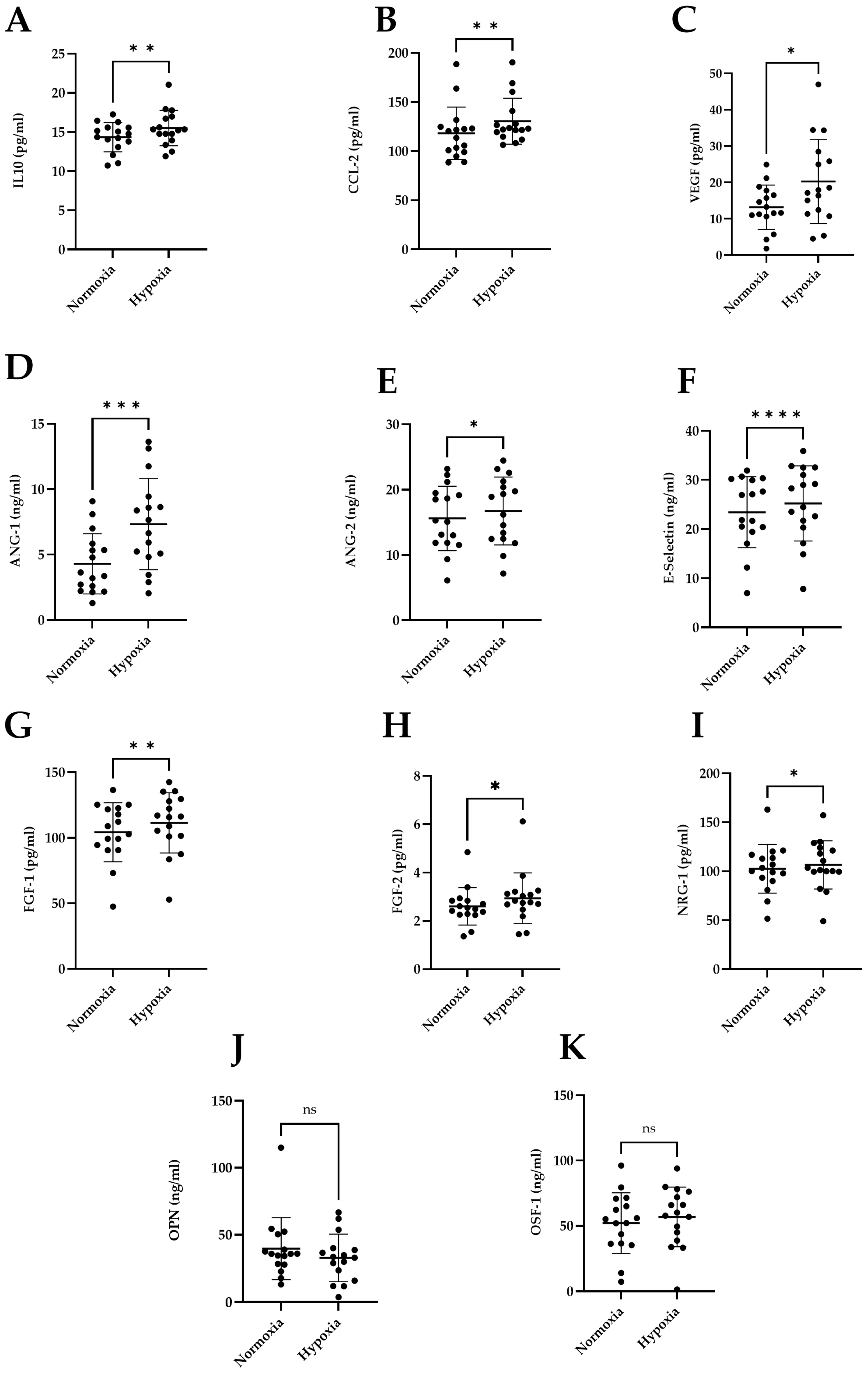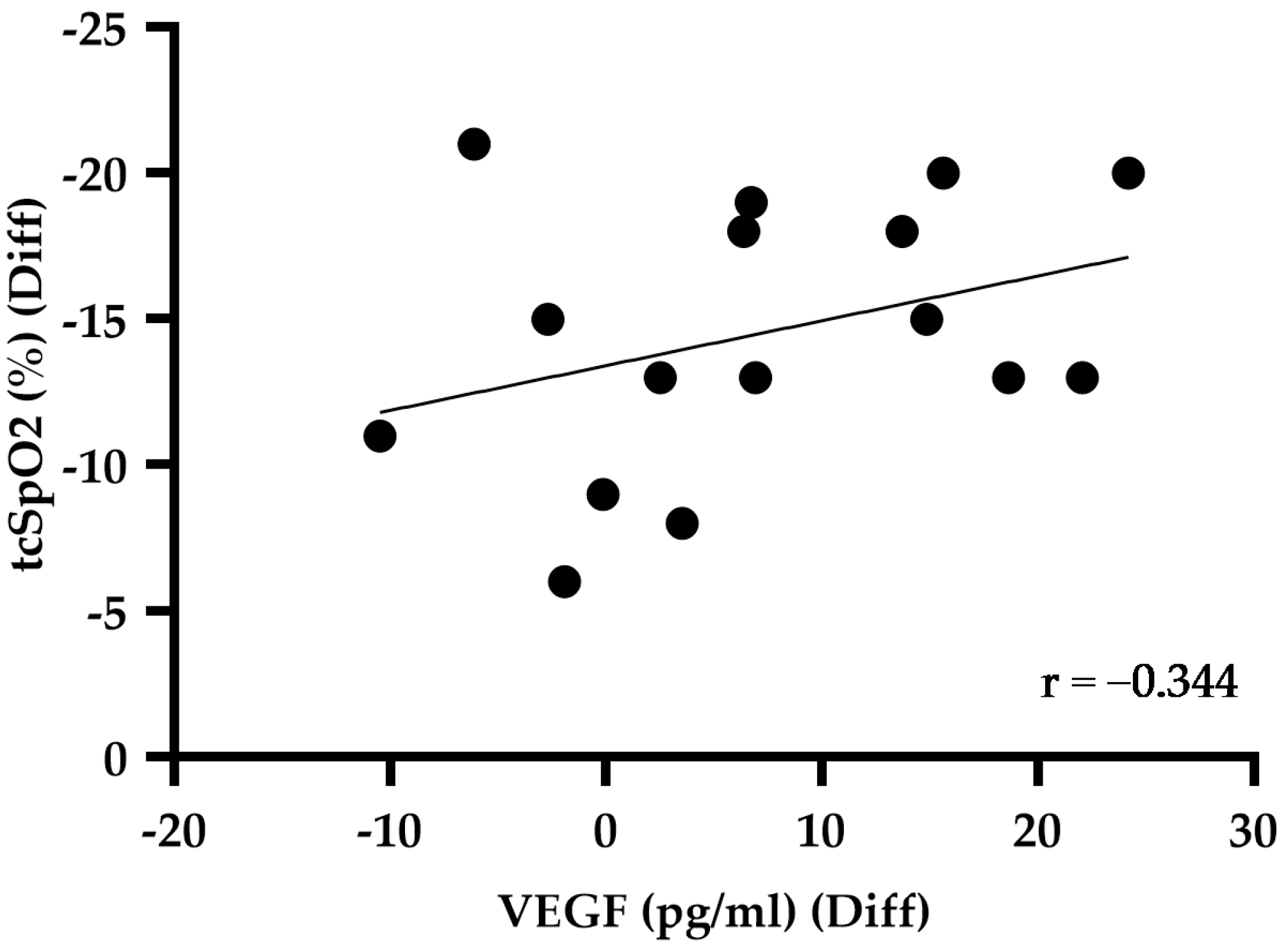Influence of Simulated Altitude Exposure (2500 m) on Patients with Fontan Palliation Based on Circulating Hypoxia-Associated Factors
Abstract
:1. Introduction
2. Results
2.1. Clinical Data
2.2. Hypoxia-Inducible Proteins and Effector Molecules
2.2.1. IL-10
2.2.2. CCL2
2.2.3. VEGF
2.2.4. ANG-1
2.2.5. ANG-2
2.2.6. E-Selectin
2.2.7. FGF-1
2.2.8. FGF-2
2.2.9. NRG-1
2.2.10. Osteopotin
2.2.11. OSF-1
3. Discussion
4. Materials and Methods
4.1. Study Populations
4.2. Study Protocol and Sample Collection
4.3. SaO2 Measurement
4.4. SpO2 Measurement
4.5. Sample Preparation
4.6. Statistical Analysis
5. Conclusions
Author Contributions
Funding
Institutional Review Board Statement
Informed Consent Statement
Data Availability Statement
Acknowledgments
Conflicts of Interest
References
- Lindinger, A.; Schwedler, G.; Hense, H.W. Prevalence of congenital heart defects in newborns in Germany: Results of the first registration year of the PAN Study (July 2006 to June 2007). Klin. Padiatr. 2010, 222, 321–326. [Google Scholar] [CrossRef] [PubMed]
- Fontan, F.; Baudet, E. Surgical repair of tricuspid atresia. Thorax 1971, 26, 240–248. [Google Scholar] [CrossRef] [PubMed]
- Lee, P.; Chandel, N.S.; Simon, M.C. Cellular adaptation to hypoxia through hypoxia inducible factors and beyond. Nat. Rev. Mol. Cell Biol. 2020, 21, 268–283. [Google Scholar] [CrossRef] [PubMed]
- Zhao, Y.; Xiong, W.; Li, C.; Zhao, R.; Lu, H.; Song, S.; Zhou, Y.; Hu, Y.; Shi, B.; Ge, J. Hypoxia-induced signaling in the cardiovascular system: Pathogenesis and therapeutic targets. Signal Transduct. Target. Ther. 2023, 8, 431. [Google Scholar] [CrossRef] [PubMed]
- Kavarana, M.N.; Jones, J.A.; Stroud, R.E.; Bradley, S.M.; Ikonomidis, J.S.; Mukherjee, R. Pulmonary arteriovenous malformations after the superior cavopulmonary shunt: Mechanisms and clinical implications. Expert Rev. Cardiovasc. Ther. 2014, 12, 703–713. [Google Scholar] [CrossRef] [PubMed]
- Boehme, J.T.; Morris, C.J.; Chiacchia, S.R.; Gong, W.; Wu, K.Y.; Kameny, R.J.; Raff, G.W.; Fineman, J.R.; Maltepe, E.; Datar, S.A. HIF-1α promotes cellular growth in lymphatic endothelial cells exposed to chronically elevated pulmonary lymph flow. Sci. Rep. 2021, 11, 1468. [Google Scholar] [CrossRef]
- Telinius, N.; Hjortdal, V.E. Role of the lymphatic vasculature in cardiovascular medicine. Heart 2019, 105, 1777–1784. [Google Scholar] [CrossRef]
- Mori, Y.; Shoji, M.; Nakanishi, T.; Fujii, T.; Nakazawa, M. Elevated vascular endothelial growth factor levels are associated with aortopulmonary collateral vessels in patients before and after the Fontan procedure. Am. Heart J. 2007, 153, 987–994. [Google Scholar] [CrossRef]
- Suda, K.; Matsumura, M.; Miyanish, S.; Uehara, K.; Sugita, T.; Matsumoto, M. Increased vascular endothelial growth factor in patients with cyanotic congenital heart diseases may not be normalized after a Fontan type operation. Ann. Thorac. Surg. 2004, 78, 942–946; discussion 946–947. [Google Scholar] [CrossRef]
- Härtel, J.A.; Müller, N.; Herberg, U.; Breuer, J.; Bizjak, D.A.; Bloch, W.; Grau, M. Altered Hemorheology in Fontan Patients in Normoxia and After Acute Hypoxic Exercise. Front. Physiol. 2019, 10, 1443. [Google Scholar] [CrossRef]
- Ibuki, K.; Imamura, T.; Nakaoka, H.; Takarada, S.; Okabe, M.; Ozawa, S.; Kinugawa, K.; Hirono, K. Serum Angiopoetin-2 Levels in Pediatric Patients After Fontan Operation. Am. J. Cardiol. 2023, 203, 23–28. [Google Scholar] [CrossRef] [PubMed]
- Hövels-Gürich, H.H.; Schumacher, K.; Vazquez-Jimenez, J.F.; Qing, M.; Hüffmeier, U.; Buding, B.; Messmer, B.J.; von Bernuth, G.; Seghaye, M.C. Cytokine balance in infants undergoing cardiac operation. Ann. Thorac. Surg. 2002, 73, 601–608; discussion 608–609. [Google Scholar] [CrossRef] [PubMed]
- Naldini, A.; Carraro, F.; Silvestri, S.; Bocci, V. Hypoxia affects cytokine production and proliferative responses by human peripheral mononuclear cells. J. Cell. Physiol. 1997, 173, 335–342. [Google Scholar] [CrossRef]
- Silvestre, J.S.; Mallat, Z.; Duriez, M.; Tamarat, R.; Bureau, M.F.; Scherman, D.; Duverger, N.; Branellec, D.; Tedgui, A.; Levy, B.I. Antiangiogenic effect of interleukin-10 in ischemia-induced angiogenesis in mice hindlimb. Circ. Res. 2000, 87, 448–452. [Google Scholar] [CrossRef]
- Härtel, J.A.; Müller, N.; Breuer, J.; Jordan, J.; Tank, J.; Bros, J.; Seeger, B.; Zollmann, E.; Bloch, W.; Grau, M. Influence of 24 h Simulated Altitude on Red Blood Cell Deformability and Hematological Parameters in Patients with Fontan Circulation. Metabolites 2022, 12, 1025. [Google Scholar] [CrossRef]
- Müller, N.; Härtel, J.A.; Schmitz, J.; Baur, U.; von der Wiesche, M.; Rieger, I.; Gerlach, D.; von Stritzky, J.; Bach, A.; Hart, C.; et al. Peripheral Oxygenation and Pulmonary Hemodynamics in Individuals With Fontan Circulation During 24-Hour High-Altitude Exposure Simulation. Circulation 2024, 149, 1466–1468. [Google Scholar] [CrossRef]
- Kraus, R.M.; Stallings, H.W., 3rd; Yeager, R.C.; Gavin, T.P. Circulating plasma VEGF response to exercise in sedentary and endurance-trained men. J. Appl. Physiol. 2004, 96, 1445–1450. [Google Scholar] [CrossRef] [PubMed]
- Saraiva, M.; Vieira, P.; O’Garra, A. Biology and therapeutic potential of interleukin-10. J. Exp. Med. 2020, 217, e20190418. [Google Scholar] [CrossRef] [PubMed]
- Kohno, T.; Mizukami, H.; Suzuki, M.; Saga, Y.; Takei, Y.; Shimpo, M.; Matsushita, T.; Okada, T.; Hanazono, Y.; Kume, A.; et al. Interleukin-10-mediated inhibition of angiogenesis and tumor growth in mice bearing VEGF-producing ovarian cancer. Cancer Res. 2003, 63, 5091–5094. [Google Scholar] [PubMed]
- Dace, D.S.; Khan, A.A.; Kelly, J.; Apte, R.S. Interleukin-10 promotes pathological angiogenesis by regulating macrophage response to hypoxia during development. PLoS ONE 2008, 3, e3381. [Google Scholar] [CrossRef] [PubMed]
- Qin, X.Y.; Shen, H.H.; Zhang, X.Y.; Zhang, X.; Xie, F.; Wang, W.J.; Xiong, Y.; Mei, J.; Li, M.Q. Hypoxia-mediated chemotaxis and residence of macrophage in decidua by secreting VEGFA and CCL2 during normal pregnancy. Reproduction 2023, 165, 543–555. [Google Scholar] [CrossRef] [PubMed]
- Lin, Z.; Shi, J.L.; Chen, M.; Zheng, Z.M.; Li, M.Q.; Shao, J. CCL2: An important cytokine in normal and pathological pregnancies: A review. Front. Immunol. 2022, 13, 1053457. [Google Scholar] [CrossRef] [PubMed]
- Zhang, J.; Huang, S.; Zhu, Z.; Gatt, A.; Liu, J. E-selectin in vascular pathophysiology. Front. Immunol. 2024, 15, 1401399. [Google Scholar] [CrossRef] [PubMed]
- Vitali, H.E.; Kuschel, B.; Sherpa, C.; Jones, B.W.; Jacob, N.; Madiha, S.A.; Elliott, S.; Dziennik, E.; Kreun, L.; Conatser, C.; et al. Hypoxia regulate developmental coronary angiogenesis potentially through VEGF-R2- and SOX17-mediated signaling. Dev. Dyn. 2024. [Google Scholar] [CrossRef]
- Naito, H.; Iba, T.; Takakura, N. Mechanisms of new blood-vessel formation and proliferative heterogeneity of endothelial cells. Int. Immunol. 2020, 32, 295–305. [Google Scholar] [CrossRef]
- Morita, H.; Hoshiga, M. Fibroblast Growth Factors in Cardiovascular Disease. J. Atheroscler. Thromb. 2024, 31, 1496–1511. [Google Scholar] [CrossRef]
- Hilbert, T.; Duerr, G.D.; Hamiko, M.; Frede, S.; Rogers, L.; Baumgarten, G.; Hoeft, A.; Velten, M. Endothelial permeability following coronary artery bypass grafting: An observational study on the possible role of angiopoietin imbalance. Crit. Care 2016, 20, 51. [Google Scholar] [CrossRef]
- Shirali, A.S.; Lluri, G.; Guihard, P.J.; Conrad, M.B.; Kim, H.; Pawlikowska, L.; Boström, K.I.; Iruela-Arispe, M.L.; Aboulhosn, J.A. Angiopoietin-2 predicts morbidity in adults with Fontan physiology. Sci. Rep. 2019, 9, 18328. [Google Scholar] [CrossRef] [PubMed]
- Huang, M.; Zheng, J.; Chen, Z.; You, C.; Huang, Q. The Relationship Between Circulating Neuregulin-1 and Coronary Collateral Circulation in Patients with Coronary Artery Disease. Int. Heart J. 2020, 61, 115–120. [Google Scholar] [CrossRef] [PubMed]
- Conway, S.J.; Izuhara, K.; Kudo, Y.; Litvin, J.; Markwald, R.; Ouyang, G.; Arron, J.R.; Holweg, C.T.; Kudo, A. The role of periostin in tissue remodeling across health and disease. Cell. Mol. Life Sci. 2014, 71, 1279–1288. [Google Scholar] [CrossRef]
- Zhang, Y.; Birru, R.; Di, Y.P. Analysis of clinical and biological samples using microsphere-based multiplexing Luminex system. Methods Mol. Biol. 2014, 1105, 43–57. [Google Scholar] [CrossRef] [PubMed]


| Age (median [range]) | Years | 24.5 [16.3–38.8] |
| Gender | f/m | 9/9 |
| SpO2 (mean ± SD) | Normoxia | 94.2 ± 3.1 |
| SpO2 (mean ± SD) | Hypoxia | 79.7 ± 6.0 |
| Congenital heart malformation | ||
| Tricuspid Atresia (TA) | 4 | |
| Pulmonary Atresia (PA) | 1 | |
| PA with congenitally corrected transposition of the great arteries (ccTGA) | 2 | |
| Hypoplastic Left Heart Syndrome (HLHS) | 2 | |
| Double-Inlet Left Ventricle (DILV) | 5 | |
| Double-Outlet Right Ventricle | 2 | |
| Double-Inlet Right Ventricle | 1 | |
| Single Ventricle with ccTGA | 1 | |
| Systemic Ventricle | ||
| Left | 10 | |
| Right | 8 | |
Disclaimer/Publisher’s Note: The statements, opinions and data contained in all publications are solely those of the individual author(s) and contributor(s) and not of MDPI and/or the editor(s). MDPI and/or the editor(s) disclaim responsibility for any injury to people or property resulting from any ideas, methods, instructions or products referred to in the content. |
© 2025 by the authors. Licensee MDPI, Basel, Switzerland. This article is an open access article distributed under the terms and conditions of the Creative Commons Attribution (CC BY) license (https://creativecommons.org/licenses/by/4.0/).
Share and Cite
Müller, N.; Hart, C.; Härtel, J.A.; Jordan, J.; Tank, J.; Breuer, J.; Grau, M.; Frede, S.; Splettstoesser, F.; Kratz, T. Influence of Simulated Altitude Exposure (2500 m) on Patients with Fontan Palliation Based on Circulating Hypoxia-Associated Factors. Int. J. Mol. Sci. 2025, 26, 887. https://doi.org/10.3390/ijms26030887
Müller N, Hart C, Härtel JA, Jordan J, Tank J, Breuer J, Grau M, Frede S, Splettstoesser F, Kratz T. Influence of Simulated Altitude Exposure (2500 m) on Patients with Fontan Palliation Based on Circulating Hypoxia-Associated Factors. International Journal of Molecular Sciences. 2025; 26(3):887. https://doi.org/10.3390/ijms26030887
Chicago/Turabian StyleMüller, Nicole, Christopher Hart, Julian Alexander Härtel, Jens Jordan, Jens Tank, Johannes Breuer, Marijke Grau, Stilla Frede, Frank Splettstoesser, and Tobias Kratz. 2025. "Influence of Simulated Altitude Exposure (2500 m) on Patients with Fontan Palliation Based on Circulating Hypoxia-Associated Factors" International Journal of Molecular Sciences 26, no. 3: 887. https://doi.org/10.3390/ijms26030887
APA StyleMüller, N., Hart, C., Härtel, J. A., Jordan, J., Tank, J., Breuer, J., Grau, M., Frede, S., Splettstoesser, F., & Kratz, T. (2025). Influence of Simulated Altitude Exposure (2500 m) on Patients with Fontan Palliation Based on Circulating Hypoxia-Associated Factors. International Journal of Molecular Sciences, 26(3), 887. https://doi.org/10.3390/ijms26030887






